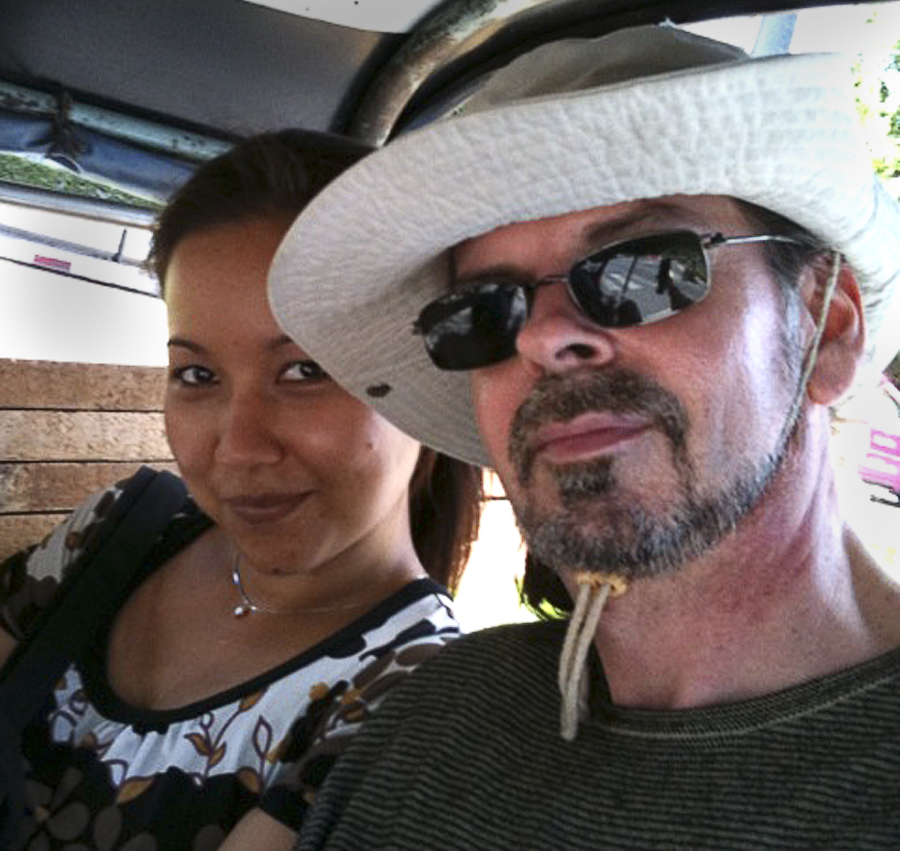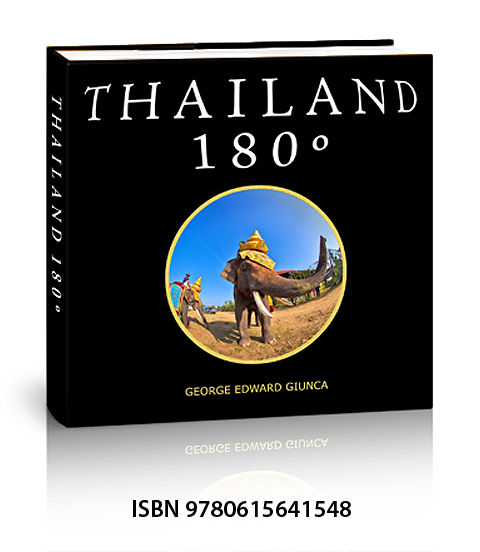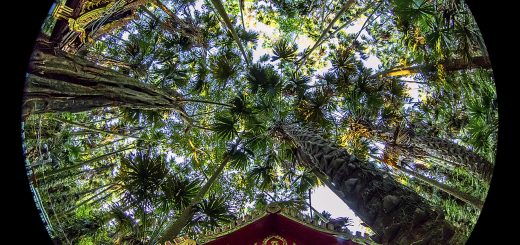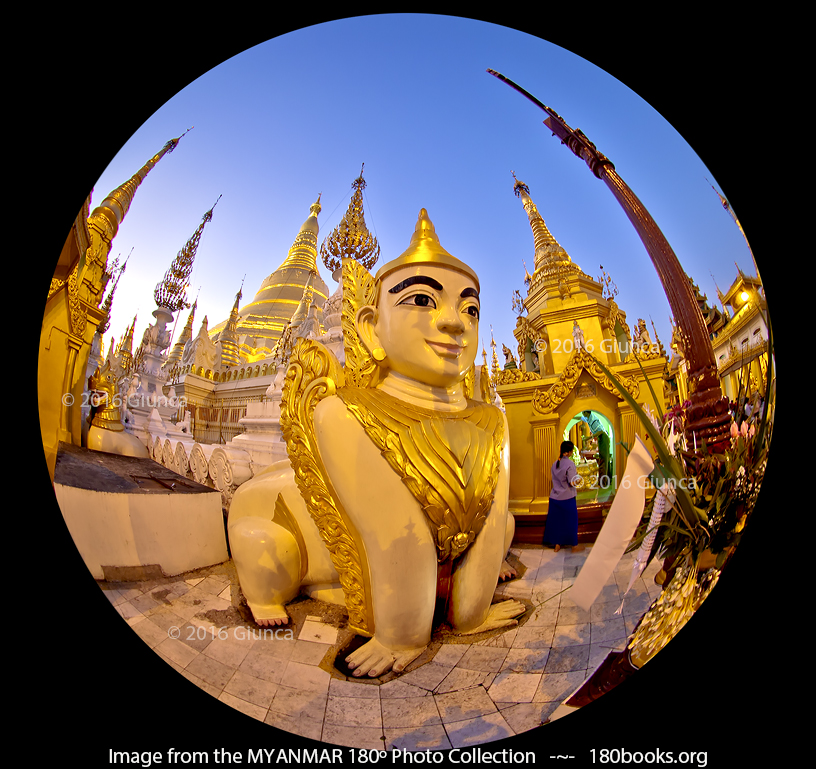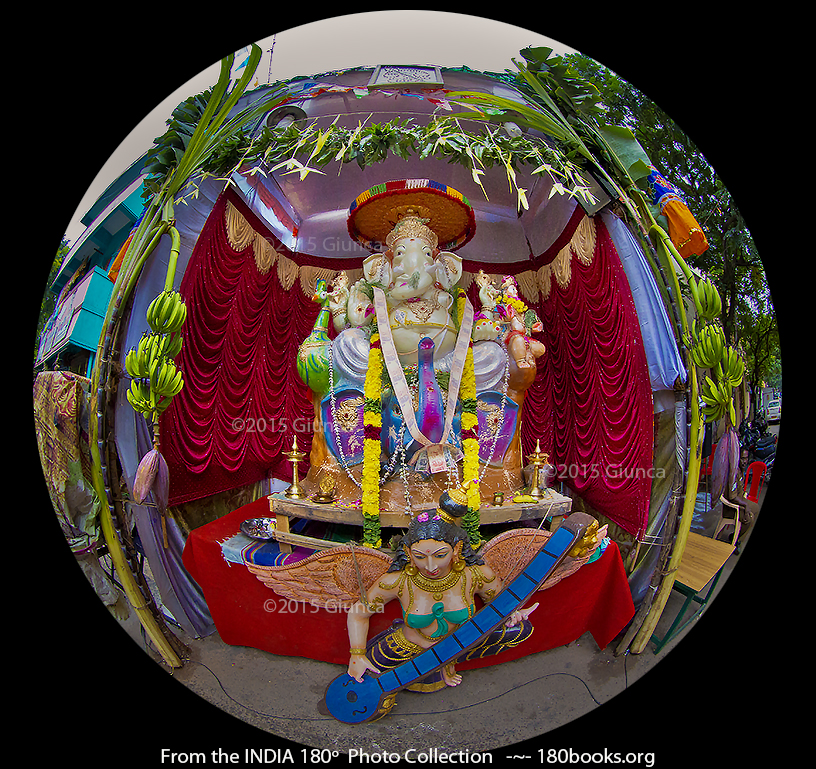Hill Tribes of THAILAND 180º, Part 2 (ชาวเขา)

Mien (Yao) Tribe Woman Creating a Hat (Image from the 180books.org Photo Collection by George Edward Giunca)
As I mentioned in Part 1, many Hill Tribes live around the mountains of Northern Thailand which I had always dreamed of taking a trek through to photograph different Hill Tribes, but in practice, I really didn’t feel it was right to invade these people’s lives and privacy. Most have been able to keep their cultural identities and avoid contact with the outside world. After shattering my ankle, a trek was out of the question for at least six months, so we were forced to find alternatives. Three months after surgery, I became impatient and we decided to spend a couple weeks in the North of Thailand and try to find a way to make some authentic photos, without disturbing their lifestyle, or my poor ankle.
ชาวเขาที่อาศัยอยู่แถบเทือกเขาทางเหนือของประเทศไทยมีหลายเผ่า … ความเดิมจากตอนที่ ๑ …คุณเอ็ดเคยใฝ่ฝันอยากจะเดินทางท่องไปในขุนเขาทางภาคเหนือเพื่อถ่ายภาพชาวเขาเผ่าต่างๆ แต่อีกแง่ของความเป็นจริงก็ไม่อยากเข้าไปรุกรานความเป็นส่วนตัวของพวกเขา หลายชนเผ่าหลีกเลี่ยงการติดต่อกับโลกภายนอกเพื่อให้คงวัฒนธรรมขนบประเพณีอันเป็นเอกลักษณ์ของเผ่าตน อีกเหตุผลหนึ่งคือเพิ่งผ่าตัดข้อเท้ามาแค่สามเดือนกว่า จะให้เดินขึ้นเขาลงห้วยคงยังไม่ได้ ดังนั้นเราเลยวางแผนเดินทางไปสถานที่ที่แสดงวิถีชีวิตความเป็นอยู่ของชุมชนชาวเขาในแถบภาคเหนือ)
Mien (Yao) Tribe
This Part 2, we’ll start with the Mien (Yao) tribe, whose history dates as far back as 5th BC. when they lived in the surrounding mountains near Tibet. They are also related to the lowland-living Lanten people of Laos and Vietnam and are believed to have begun migrating from the Hunan province in China during the 15th-16th century. Their tribe spread throughout northern Vietnam, northern Laos and northern Thailand. After the Indochina War, the army from Laos took revenge on the Mein tribesmen who had enlisted in a CIA secret army and they fled to Thailand. The United States accepted many of the refugees from the Mein and Hmong tribes and naturalized them as citizens. Today it’s estimated that there are around 50,000 Miens living in the United States, mostly on the West Coast, in California. The image above shows a Mien woman working on a headpiece which is a part of their traditional ethnic costume, made from cotton fabric with embroidered in cross-stitch. She was smiling and singing to herself as she worked, wrapping and unwrapping the hat until she was satisfied.
บล๊อกนี้มาต่อเป็นตอนที่ ๒ — (ภาพด้านบน) ชาวเมี่ยนหญิงท่านนี้กำลังพันผ้าโพกศีรษะอันเป็นหนึ่งในเครื่องแต่งกายที่เป็นเอกลักษณ์ของสตรีเผ่าเมี่ยน “เมี่ยน” หรือที่เราคุ้นหูว่า “เย้า” แต่พวกเขาเรียกตัวเองว่า เมี่ยน (Mien) หรือ อิ้วเมี่ยน (Iu Mien) อันมีชื่อของชนเผ่าปรากฏในหลักฐานบันทึกของจีนช่วงคริสตศตวรรษที่ ๕ เมื่อครั้งจีนปกครองโดยราชวงศ์ต่างๆ ชาวเมี่ยนได้อพยพไปอาศัยในเทือกเขาสูงเพื่อปกป้องเสรีภาพและการถูกคุกคาม จากนั้นจึงอพยพลงมาทางตอนใต้เข้าสู่ภาคเหนือของเวียดนามในราวศตวรรตที่ ๑๕-๑๖ และอพยพเข้าสู่ตอนเหนือของประเทศไทยเมื่อร้อยกว่าปีมานี้เอง

Lahu (Muser) Tribe Man Carving a Bamboo Cup (Image from the 180books.org Photo Collection by George Edward Giunca)
Lahu (Muser) Tribe
There are about 150,000 Lahu people living in Thailand, especially in Chiang Mai, Chiang Rai, Mae Hong Son, Tak, and Lampang. They too originally lived in China in the area around the Tibetan plateau. The Lahu have migrated in the past two hundred years to bordering Southeast Asian countries. In 1975, many were accepted as refugees in the United States. The Thai name for the Lahu is Muser, means hunter, and the Chinese refer to the Lahu as tiger hunters. While they are proud of their hunter-warrior heritage, today they are mainly farmers and grow rice and corn for their own consumption.
These days many Lahu people have adopted the religious, festival, language and dress of wherever country they live in. The bamboo stalk that they use to make their traditional wind music instruments has led them to a new idea of making drinking mugs as souvenir to sell to the tourists. I can personally attest to the fact that the mug keeps a beer cold! I have to smile that he seems to prefer drinking his tea from a glass. 😉
“ลาหู่” หรือคนไทยเรียก “มูเซอ” มีถิ่นฐานดั้งเดิมอยู่ในธิเบตและภาคตะวันตกเฉียงใต้ของจีน ส่วนที่อพยพเข้ามาในประเทศไทยมีอยู่ราวแสนกว่าคนกระจายอยู่ตามหมู่บ้านในพื้นที่จังหวัดเชียงใหม่, เชียงราย, แม่ฮ่องสอน, ตาก, และลำปาง โดยเฉพาะตามพื้นที่ติดชายแดน ชนเผ่าลาหู่ได้แบ่งเป็นเผ่าย่อยอีกหลายเผ่า เผ่าลาหู่ที่ใหญ่ที่สุดในประเทศไทย คือ ลาหู่แดง ซึ่งมีการนับถือผี โดยโตโบหรือผู้นำทางศาสนา ส่วนใหญ่ยังชีพด้วยการปลูกข้าวและข้าวโพดเพื่อการบริโภคในครัวเรือน
ชาวลาหู่นั้นมีการปรับตัวเองตามสภาพแวดล้อมที่ตนอาศัยอยู่ ดังนั้นจึงไม่แปลกที่เราพบชาวลาหู่บางท่านนับถือศาสนาคริสต์และพุทธ สวมเสื้อยืดกางเกงยีนส์ หรือขับมอเตอร์ไซค์ขึ้นดอย ไม้ไผ่ที่สมัยก่อนถูกเหลาตัดแต่งเป็นเครื่องดนตรีและภาชนะใช้สอยในครัวเรือน ปัจจุบันมีไอเดียการประดิษฐ์และสลักลวดลายเพื่อขายเป็นสินค้าที่ระลึกแก่นักท่องเที่ยว นับเป็นการปรับวิถีชีวิตตามพื้นที่อาศัยและยุคสมัยเพื่อการดำรงชีวิต

Kayan Lahwi (Long Neck) Tribe Woman Winding Thread (Image from the 180books.org Photo Collection by George Edward Giunca)
Kayan Lahwi (Long Neck)
As we walked farther into the mountains, we found some women with brass neck coils spinning cotton into thread with a hand spindle and weaving on a foot-treadle loom. A group of children wearing western clothes came bounding through the village and started singing songs in English. They all practiced their hello, good-bye and glad to meet you greetings, following us as we continued on our village tour.
เดินต่อมาเรื่อยๆ ก็พบเอกลักษณ์โดดเด่นที่สุดของผู้หญิงในเผ่านี้ คือ สวมห่วงทองเหลืองที่ลำคอและนี่คือ หมู่บ้าน “กะเหรี่ยงคอยาว” พวกเขาต้องการให้เรียกว่า “กะยัน” หรือ “กะย้าน” ไม่ใช่ปะด่องตามภาษาไทยใหญ่ สตรีชาวกะยันหรือกะเหรี่ยงคอยาวกำลังปั่นฝ้ายให้เป็นเส้นด้ายก่อนนำไปทอด้วยกี่เอว ขณะเดียวกันก็ได้ยินเสียงเด็กๆกำลังร้องเพลงและฝึกพูดทักทายภาษาอังกฤษกันอย่างสนุกสานาน
Kayan Lahwi tribesmen originated 3,600 years ago in Mongolia, before migrating south to Shan state in Myanmar. Many Kayan people fled to the Thai border area around Mae Hong Son and Chiang Rai during the conflicts with the military regime in Myanmar in the early 1990s.
Girls begin wearing the brass neck coils when they are around 5-9 year old, installed by a ritual performer who chooses an auspicious day for each girl. And yes, they add more, replace, and resize as both an occasion or {gasp!} punishment.
ชาวกะเหรี่ยงคอยาว มีถิ่นฐานเดิมอยู่บริเวณมองโกเลียราว ๓,๖๐๐ ปีมาแล้ว และอพยพย้ายถิ่นฐานจนเข้ามาในรัฐฉานประเทศเมียนมาร์ แต่เนื่องจากระยะหนึ่งที่เมียนมาร์มีสงครามภายในทำให้ชาวกะเหรี่ยงคอยาวอพยพมาอยู่ในแถบแม่ฮ่องสอน และเชียงราย
การใส่ห่วงคอทองเหลืองนั้น เริ่มตั้งแต่เด็กสาวปาดองมีอายุ ๕ – ๙ ปี โดยมีหมอผีประจำเผ่าเป็นผู้ทำพิธีใส่ให้ ก่อนใส่จะต้องทำนายหาฤกษ์ยามที่ดีที่สุด และแน่นอนว่าต้องมีเปลี่ยนขนาดและเพิ่มความยาวของขดทองเหลืองตามวาระ

Akha Tribe Women posing for a photo (Image from the 180books.org Photo Collection by George Edward Giunca)
Akha Tribe
The Akha claim their original homeland was the Tibetan borderlands or close to Yunnan province, China, before migrating into Southeast Asia early in the 20th century. Civil wars in Myanmar hastened the flow of Akha immigrants and there are now around 80,000 living in Thailand’s northern provinces of Chiang Rai and Chiang Mai. Although he Akha speak Akha, a branch of the Tibeto-Burman language group, they don’t have a traditional written language. Missionaries or linguists tried to help them develop a language using Roman, Thai or Burmese characters, but literacy amongst the Akha never has taken hold. Few Akha in Thailand are citizens and most are registered as aliens. Like many of the hill tribes, the Akha usually build their villages with traditional houses at higher elevations in the mountains, but villages built closer to modern towns tend to be more Westernized in style.
“อาข่า” ชื่อนี้มาจากความเชื่อที่ว่า ถ้าอยู่ใกล้แม่น้ำมีโรคภัยไข้เจ็บมาก จึงมักอยู่ดอยสูง ปัจจุบันกระจายตัวในแถบประเทศจีน เมียนมาร์ ไทย ลาว และเวียดนาม ซึ่งอาข่ามีภาษาพูดของตัวเองแต่ไม่มีภาษาเขียน สำหรับชาวอาข่าที่อพยพเข้ามาสู่ประเทศไทยมี ๒ กลุ่ม คือ กลุ่มที่อพยพจากเชียงตุงประเทศเมียนมาร์ซึ่งเป็นกลุ่มใหญ่ที่ลี้ภัยสงคราม และอีกกลุ่มหนึ่งอพยพมาจากสิบสองปันนา โดยผ่านรอยตะเข็บของประเทศเมียนมาร์และลาว เข้าสู่ประเทศไทยโดยตรงที่จังหวัดเชียงราย ปัจจุบันมีชาวอาข่าอาศัยอยู่ในประเทศไทยราว ๘๐,๐๐๐ คน แต่มีเพียงไม่กี่คนที่ได้รับสัญชาติไทย ส่วนมากยังคงอาศัยอยู่ในจังหวัดเชียงรายและเชียงใหม่ มีส่วนหนึ่งที่อพยพไปขายแรงงานในจังหวัดอื่นๆ
The Akha are traditionally are farmers and grow a variety of crops including rice and corn for their own village. Modern Akha now farm for a living growing cash crops that include chilies, soybeans, cabbages, and tomatoes. Sometimes a few families in a village may run a small business in their home selling items such as cigarettes, gasoline and kerosene. Tourism is also a growing opportunity for the Akha and prompts them to dress in their elaborate costumes and sell handicrafts, blankets. The most spectacular item of their costume is the headdresses for women that are made of silver and decorated with silver coins, white beaded sporran, and dyed chicken feathers. Each one is a unique piece of art and sometimes finds its way into bazaars. I confess I bought an entire man’s traditional costume that I occasionally wear around our house. Especially when I’m working on a blog like today!
I love handicraft and primitive art /tribal art and buying pieces directly from them means the money goes into Their pocket and supports their creativity.
ชาวอาข่าดำรงชีพด้วยการทำเกษตรปลูกข้าวและข้าวโพดเป็นหลัก และปลูกพืชเพื่อการพาณิชย์ เช่น พริก, ถั่วเหลือง, กะหล่ำปลี, และมะเขือเทศ มีเพียงบางครอบครัวที่เปิดร้านค้าและปั๊มน้ำมันหลอด ในขณะที่ปัจจุบันมีการส่งเสริมการท่องเที่ยวทำให้บางหมู่บ้านเปิดรับนักท่องเที่ยวเข้าชมวิถีชีวิตและจำหน่ายสินค้าที่ระลึก สินค้าหัตถกรรม รวมไปถึงเครื่องแต่งกายประจำเผ่า ซึ่งจุดเด่นของเครื่องแต่งกายเผ่าอาข่าคือ หมวกหรืออู่โซว้ะ เครื่องประดับศีรษะของสตรีที่ทำจากเงินบุผ้าฝ้ายและประดับด้วยเหรียญ, ลูกปัดจาก, และขนไก่ย้อมสี เป็นเอกลักษณ์โดดเด่นและบ่งบอกเผ่าพันธุ์ชัดเจนว่าเป็นอาข่า
แน่นอนว่าเรากลับมาออกมาจากหมู่บ้านชาวเขาแต่ละเผ่าพร้อมของที่ระลึกมากมายเต็มไม้เต็มมือเหมือนเคย ด้วยความต้องการสนับสนุนงานศิลปะหัตถกรรมและบรรพศิลป์/อนารยศิลป์ของพวกเขาแบบไม่ผ่านพ่อค้าคนกลาง
!!..คลิ๊กแผนที่..!! ดูภาพสวยๆ อ่านบล็อกสถานที่ท่องเที่ยวจาก THAILAND 180º ได้นะคะ อัพเดทเพิ่มเติมตลอดค่ะ
We had to eliminate the ability to comment from this wordpress site due to excessive spam. If you enjoyed this story, subscribe using the “Subscribe” button below, or visit our facebook fan page to comment Here
We’d LOVE to hear from you!
ผู้ติดตามอ่านบล็อก สามารถติดตามอัพเดทโพสต์บล็อกได้โดยสมัครสมาชิกที่บล็อกนี้ หรือ กดไลค์เฟสบุ๊คเพจของเราที่นี่ Here
Blog : Thai by Apisatha Giunca
Blog : English by George Edward Giunca
About the Authors
Photographer George Edward Giunca, and his Thai wife, Apisatha, have traveled around Thailand armed with a circular fisheye lens to create a photo essay on the rich cultural diversity, and abundant natural beauty of the Kingdom of Thailand. Fleeing from angry water buffaloes, slapping huge mosquitoes, watching exotic festivals and religious rituals, gorging on delicious spicy food, applying aloe vera cream to sunburned skin, wading through rice paddies, getting drenched to the bone by heavy monsoon rains, and gawking at breath-taking scenery; made it a journey of epic proportions! The result is the book, THAILAND 180º. Later, they traveled extensively through Myanmar, Malaysia, and India, gathering a massive collections of 180º photos. They currently live in Chiang Mai where they continue to blog and are now working on a CHIANG MAI 180º book.
Here’s How to Order Your Copy of THAILAND 180º Collectors EditionToday!
In Thailand —>>>http://www.thailand180.com/thaiorder.html
The Rest of the world: We are offering our book on Amazon.com, below list price and I’ll pay for the shipping within the United States! http://amzn.to/1knDPRR
Not Familiar with Our Book???
This show details the origin of 180 Books, a series of art/travel books illustrated with a circular fisheye lens. By using infographics, pictures from our THAILAND 180º book, and never seen before images from our vault, we’ll demonstrate this unique lens and present our unique books.
Also, because there’s nothing to watch on TV, here’s a trailer about our book, “THAILAND 180”
Above is an interactive map of Thailand. If you click on a marker it reveals a photo from our THAILAND 180º book and a link to our blog article about the photo. Go Ahead~ Start Exploring ~Have Some Fun!


